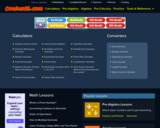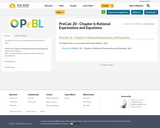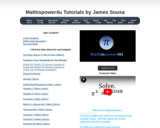
This site offers the opportunity for high school students to enter an algebra problem to see how it is best solved.
- Subject:
- Calculus
- Math
- Pre-Calculus
- Material Type:
- Activity/Lab
- Homework/Assignment
- Author:
- Mathway
- Date Added:
- 03/27/2020

This site offers the opportunity for high school students to enter an algebra problem to see how it is best solved.

Excellent Interactive Lessons AND Assessments for All Levels of Math for Teachers and Students

Free online math games, lessons, practice, puzzles, books (Geometry, algebra, pre-calculus)

Precalculus is intended for college-level Precalculus students. Since Precalculus courses vary from one institution to the next, we have attempted to meet the needs of as broad an audience as possible, including all of the content that might be covered in any particular course. The result is a comprehensive book that covers more ground than an instructor could likely cover in a typical one- or two-semester course; but instructors should find, almost without fail, that the topics they wish to include in their syllabus are covered in the text. Many chapters of Openstax Precalculus are suitable for other freshman and sophomore math courses such as College Algebra and Trigonometry; however, instructors of those courses might need to supplement or adjust the material. Openstax will also be releasing a College Algebra and Trigonometry title tailored to the particular scope, sequence, and pedagogy of those courses.

Precalculus is intended for college-level Precalculus students. Since Precalculus courses vary from one institution to the next, we have attempted to meet the needs of as broad an audience as possible, including all of the content that might be covered in any particular course. The result is a comprehensive book that covers more ground than an instructor could likely cover in a typical one- or two-semester course; but instructors should find, almost without fail, that the topics they wish to include in their syllabus are covered in the text. Many chapters of Openstax Precalculus are suitable for other freshman and sophomore math courses such as College Algebra and Trigonometry; however, instructors of those courses might need to supplement or adjust the material. Openstax will also be releasing a College Algebra and Trigonometry title tailored to the particular scope, sequence, and pedagogy of those courses.

Watch. Practice. Learn almost anything for free.
Now with ELA!
*Math K-12 (including "get ready for grade X to prepare") + college level
*Computing
*Science
*Arts, Business & Humanities
*Reading & ELA
*Life Skills - growth mindset, AI, financial literacy, SEL, safety, career
*Economics

Prepare for the year ahead by completing these mini math courses. These could be completed over the summer or once school is back in session!
Grades 3-8
Algebra 1
Geometry
Algebra 2
Precalculus
Calculus
Statistics

This PeBL PreCalc unit was submitted by Sandra Baldwin - 2016.

Precalculus is adaptable and designed to fit the needs of a variety of precalculus courses. It is a comprehensive text that covers more ground than a typical one- or two-semester college-level precalculus course. The content is organized by clearly-defined learning objectives, and includes worked examples that demonstrate problem-solving approaches in an accessible way.

Module 2 extends the concept of matrices introduced in Module 1. Students look at incidence relationships in networks and encode information about them via high-dimensional matrices. Matrix properties are studied as well as the role of the zero and identity matrices. Students then use matrices to study and solve higher order systems of equations. Vectors are introduced, and students study the arithmetic of vectors and vector magnitude. The module ends as students program video games using matrices and vectors.

Students revisit the fundamental theorem of algebra as they explore complex roots of polynomial functions. They use polynomial identities, the binomial theorem, and Pascals Triangle to find roots of polynomials and roots of unity. Students compare and create different representations of functions while studying function composition, graphing functions, and finding inverse functions.
Find the rest of the EngageNY Mathematics resources at https://archive.org/details/engageny-mathematics.

This module revisits trigonometry that was introduced in Geometry and Algebra II, uniting and further expanding the ideas of right triangle trigonometry and the unit circle. New tools are introduced for solving geometric and modeling problems through the power of trigonometry. Students explore sine, cosine, and tangent functions and their periodicity, derive formulas for triangles that are not right, and study the graphs of trigonometric functions and their inverses.

In this module, students build on their understanding of probability developed in previous grades. In Topic A the multiplication rule for independent events introduced in Algebra II is generalized to a rule that can be used to calculate probability where two events are not independent. Students are also introduced to three techniques for counting outcomes. Topic B presents information related to random variables and discrete probability distributions. Topic C is a capstone topic for this module, where students use what they have learned about probability and expected value to analyze strategies and make decisions in a variety of contexts.

(Nota: Esta es una traducción de un recurso educativo abierto creado por el Departamento de Educación del Estado de Nueva York (NYSED) como parte del proyecto "EngageNY" en 2013. Aunque el recurso real fue traducido por personas, la siguiente descripción se tradujo del inglés original usando Google Translate para ayudar a los usuarios potenciales a decidir si se adapta a sus necesidades y puede contener errores gramaticales o lingüísticos. La descripción original en inglés también se proporciona a continuación.)
El módulo 2 extiende el concepto de matrices introducidas en el módulo 1. Los estudiantes analizan las relaciones de incidencia en las redes y codifican información sobre ellas a través de matrices de alta dimensión. Se estudian las propiedades de la matriz, así como el papel de las matrices cero y de identidad. Luego, los estudiantes usan matrices para estudiar y resolver sistemas de ecuaciones de orden superior. Se introducen vectores y los estudiantes estudian la aritmética de los vectores y la magnitud del vector. El módulo termina cuando los estudiantes programan videojuegos usando matrices y vectores.
English Description:
Module 2 extends the concept of matrices introduced in Module 1. Students look at incidence relationships in networks and encode information about them via high-dimensional matrices. Matrix properties are studied as well as the role of the zero and identity matrices. Students then use matrices to study and solve higher order systems of equations. Vectors are introduced, and students study the arithmetic of vectors and vector magnitude. The module ends as students program video games using matrices and vectors.

(Nota: Esta es una traducción de un recurso educativo abierto creado por el Departamento de Educación del Estado de Nueva York (NYSED) como parte del proyecto "EngageNY" en 2013. Aunque el recurso real fue traducido por personas, la siguiente descripción se tradujo del inglés original usando Google Translate para ayudar a los usuarios potenciales a decidir si se adapta a sus necesidades y puede contener errores gramaticales o lingüísticos. La descripción original en inglés también se proporciona a continuación.)
Los estudiantes vuelven a visitar el teorema fundamental del álgebra mientras exploran raíces complejas de funciones polinomiales. Utilizan identidades polinomiales, el teorema binomial y el triángulo de Pascal para encontrar raíces de polinomios y raíces de la unidad. Los estudiantes comparan y crean diferentes representaciones de funciones mientras estudian composición de funciones, gráficos de funciones y encuentran funciones inversas.
Encuentre el resto de los recursos matemáticos de Engageny en https://archive.org/details/engageny-mathematics.
English Description:
Students revisit the fundamental theorem of algebra as they explore complex roots of polynomial functions. They use polynomial identities, the binomial theorem, and Pascals Triangle to find roots of polynomials and roots of unity. Students compare and create different representations of functions while studying function composition, graphing functions, and finding inverse functions.
Find the rest of the EngageNY Mathematics resources at https://archive.org/details/engageny-mathematics.

(Nota: Esta es una traducción de un recurso educativo abierto creado por el Departamento de Educación del Estado de Nueva York (NYSED) como parte del proyecto "EngageNY" en 2013. Aunque el recurso real fue traducido por personas, la siguiente descripción se tradujo del inglés original usando Google Translate para ayudar a los usuarios potenciales a decidir si se adapta a sus necesidades y puede contener errores gramaticales o lingüísticos. La descripción original en inglés también se proporciona a continuación.)
Este módulo revisa la trigonometría que se introdujo en la geometría y el álgebra II, uniendo y ampliando aún más las ideas de la trigonometría del triángulo recto y el círculo unitario. Se introducen nuevas herramientas para resolver problemas geométricos y de modelado a través del poder de la trigonometría. Los estudiantes exploran funciones sinuso, coseno y tangentes y su periodicidad, derivan fórmulas para triángulos que no son correctos y estudian los gráficos de las funciones trigonométricas y sus inversos.
English Description:
This module revisits trigonometry that was introduced in Geometry and Algebra II, uniting and further expanding the ideas of right triangle trigonometry and the unit circle. New tools are introduced for solving geometric and modeling problems through the power of trigonometry. Students explore sine, cosine, and tangent functions and their periodicity, derive formulas for triangles that are not right, and study the graphs of trigonometric functions and their inverses.

Six-thousand-plus ad-free "mini-lessons" and videos for math, developed by Phoenix College math instructor James Sousa.